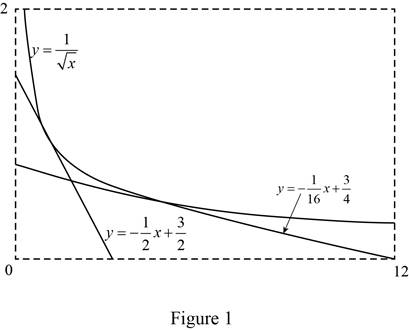
(a)
To find: The slope of the tangent line to the curve at the given point.
(a)
Answer to Problem 10E
The slope of the tangent line to the curve
Explanation of Solution
Given:
The equation of the curve is
The curve passing through the points (1, 1) and
Formula used:
The slope of the tangent curve
Difference of square formula:
Calculation:
Obtain the slope of the tangent to the curve at the point
Since
Multiply both the numerator and the denominator by the conjugate of the numerator.
Apply the difference of squares formula,
Since the limit x approaches to a but not equal to a, cancel the common term
Perform the mathematical operations and compute the value of the function as shown below.
Thus, the slope of the tangent line to the curve at the point
(b)
To find: The equation of the tangent lines to the curve at the given points.
(b)
Answer to Problem 10E
The equation of the tangent lines to the curve
Explanation of Solution
Formula used:
The equation of the tangent line to the curve
Calculation:
Obtain the equation of the tangent line at the point (1, 1).
Since the tangent line to the curve
At the point (1, 1), consider
Substitute
Isolate y as shown below:
Thus, the equation of the tangent line is
Obtain the equation of the tangent line at the point
Since the tangent line to the curve
At the point
Substitute
Isolate y as shown below.
Thus, the equation of the tangent line is
(c)
To sketch: The graph of the curve and the tangent lines.
(c)
Explanation of Solution
Given:
The equation of the curve is
The equation of the tangent lines are
Graph:
Use the online graphing calculator to draw the graph of the functions as shown below in Figure 1.

From Figure 1, it is noticed that the two lines
Chapter 2 Solutions
Single Variable Calculus: Concepts and Contexts, Enhanced Edition
- A 20 foot ladder rests on level ground; its head (top) is against a vertical wall. The bottom of the ladder begins by being 12 feet from the wall but begins moving away at the rate of 0.1 feet per second. At what rate is the top of the ladder slipping down the wall? You may use a calculator.arrow_forwardExplain the focus and reasons for establishment of 12.4.1(root test) and 12.4.2(ratio test)arrow_forwarduse Integration by Parts to derive 12.6.1arrow_forward
- Explain the relationship between 12.3.6, (case A of 12.3.6) and 12.3.7arrow_forwardExplain the key points and reasons for the establishment of 12.3.2(integral Test)arrow_forwardUse 12.4.2 to determine whether the infinite series on the right side of equation 12.6.5, 12.6.6 and 12.6.7 converges for every real number x.arrow_forward
- use Corollary 12.6.2 and 12.6.3 to derive 12.6.4,12.6.5, 12.6.6 and 12.6.7arrow_forwardExplain the focus and reasons for establishment of 12.5.1(lim(n->infinite) and sigma of k=0 to n)arrow_forwardExplain the focus and reasons for establishment of 12.5.3 about alternating series. and explain the reason why (sigma k=1 to infinite)(-1)k+1/k = 1/1 - 1/2 + 1/3 - 1/4 + .... converges.arrow_forward
 Calculus: Early TranscendentalsCalculusISBN:9781285741550Author:James StewartPublisher:Cengage Learning
Calculus: Early TranscendentalsCalculusISBN:9781285741550Author:James StewartPublisher:Cengage Learning Thomas' Calculus (14th Edition)CalculusISBN:9780134438986Author:Joel R. Hass, Christopher E. Heil, Maurice D. WeirPublisher:PEARSON
Thomas' Calculus (14th Edition)CalculusISBN:9780134438986Author:Joel R. Hass, Christopher E. Heil, Maurice D. WeirPublisher:PEARSON Calculus: Early Transcendentals (3rd Edition)CalculusISBN:9780134763644Author:William L. Briggs, Lyle Cochran, Bernard Gillett, Eric SchulzPublisher:PEARSON
Calculus: Early Transcendentals (3rd Edition)CalculusISBN:9780134763644Author:William L. Briggs, Lyle Cochran, Bernard Gillett, Eric SchulzPublisher:PEARSON Calculus: Early TranscendentalsCalculusISBN:9781319050740Author:Jon Rogawski, Colin Adams, Robert FranzosaPublisher:W. H. Freeman
Calculus: Early TranscendentalsCalculusISBN:9781319050740Author:Jon Rogawski, Colin Adams, Robert FranzosaPublisher:W. H. Freeman
 Calculus: Early Transcendental FunctionsCalculusISBN:9781337552516Author:Ron Larson, Bruce H. EdwardsPublisher:Cengage Learning
Calculus: Early Transcendental FunctionsCalculusISBN:9781337552516Author:Ron Larson, Bruce H. EdwardsPublisher:Cengage Learning





